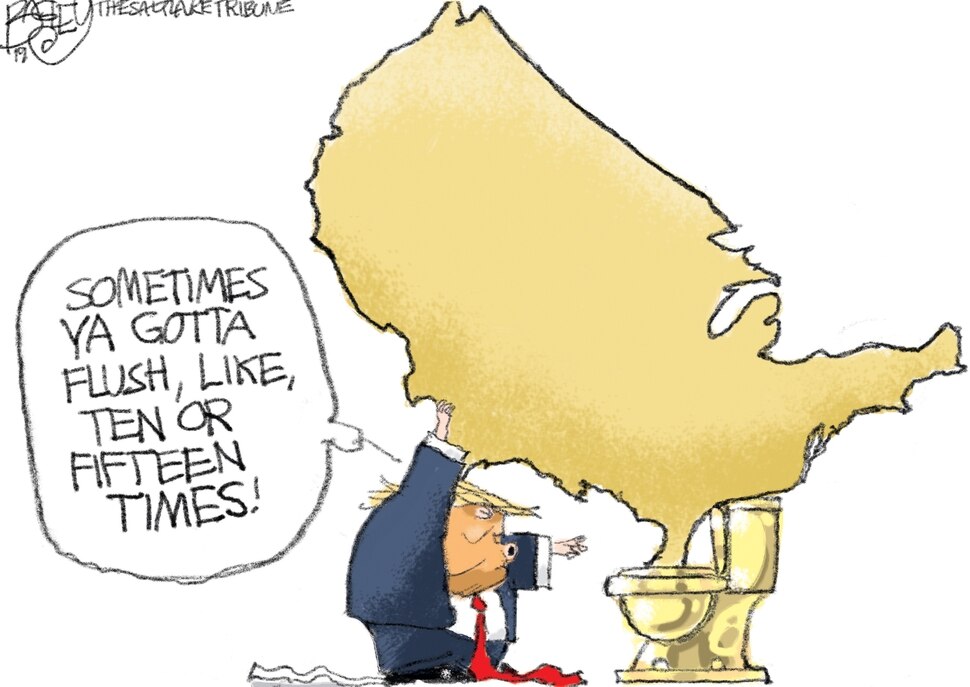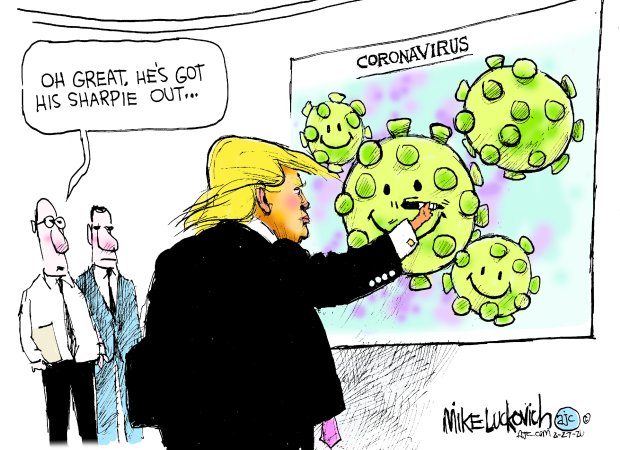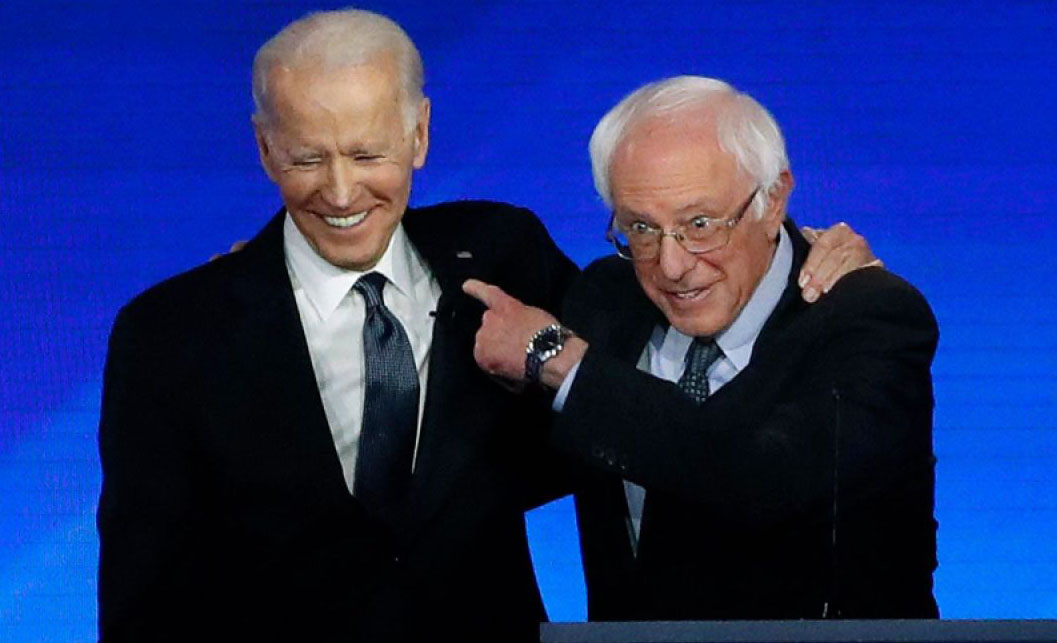While doing some maintainance on Mahablog today I came across a post I wrote in 2007, On Our Own. It was about the Bush Administration, but it could have been applied to Trump.
I’d say what we’re really dealing with is not a lack of leadership, but negative leadership. By that I mean a stubborn refusal to deal rationally with the nation’s problems accompanied by an equally stubborn refusal not to let anyone else deal with those problems, either. The Bush Administration accumulates power and won’t share it with anyone, but neither will the Bush Administration use that power to anyone’s benefit but its own.
I say you could substitute “Trump” for “Bush” and it would still be true, except now it’s worse. As we’ve seen, one of the several reasons the administration has failed to respond to the pandemic is that Trump’s people are afraid to so much as breathe without orders from Trump. So the Trump appointees leading the CDC and FDA did not take actions that were within their power. This includes functions those agencies had exercised in previous administrations, such as quickly giving private labs the go-ahead to develop tests. Weeks were wasted.
There is also a fascinating parallel between the Trumpies and the Bushies in the way they stubbornly refused to heed warnings — about terrorism or pandemics — and then, like Condi Rice, complained “no one could have imagined” a warned-about thing would happen after the warned-about thing did happen. See Aaron Blake, Trump keeps saying ‘nobody’ could have foreseen coronavirus. We keep finding out about new warning signs.
Back to what I wrote in 2007,
A year ago The Center for America’s Future released a report (PDF) documenting the failures of the Bush Administration to respond to Katrina. The Bushies failed to prepare, they failed to respond, and they have failed to rebuild. And behind these failures was more than just sheer incompetence; it was conservative ideology. The disabling factors were rightie disdain for government, their reckless determination to privatize core functions (placing blind faith in the market without oversight or accountability) and their fondness for “pay-to-play” politics, in which money capitalism and personal gain count for more than performance. These three “beliefs,” beloved of the extreme Right, are crippling America.
And, unfortunately, not nearly enough was done in the Obama years to push back against this nonsense. I’m being hard on Republicans, but Democrats have been way too accommodating to the whackjobs for lo these many years. That’s got to stop.
Mr. Ivanka, Trump’s pea-brained son-in-law, has set up what’s being called a “shadow task force” in the White House that is tasked with improving testing and health care delivery. He’s pulled together random people from private industry — officials from UPS and FedEx, for example — with some of his allies in government to work independently of everyone else in Washington and otherwise be in the way. Mr. Ivanka wants to bring “an entrepreneurial approach” to the pandemic crisis. Seriously, he said that.
Kushner defended his role in an interview, saying his team’s goal was to bring “an entrepreneurial approach” to the crisis.
“We’re getting things done in record speeds and are doing everything possible to avoid damage and mitigate the negative impacts,” Kushner said. “In America, some of our best resources are in our private sector. The federal government is not designed to solve all our problems; a lot of the muscle is in the private sector and there’s also a lot of smart people.”
Recalling what an absolute mess Mr. Ivanka has made of the Israeli-Palestinian conflict, I’d say we’re doomed. Kushner’s entrepreneurs are mostly causing chaos, according to WaPo. Senior officials say they are confused by all the emails they get from private industry employees connected to Kushner’s team, and they worry that the shadow people aren’t following government security protocols. “We don’t know who these people are,” one senior official said.
Kushner said, “The federal government is not designed to solve all our problems.” Not all problems, of course, but in times past it has done a damn good job addressing problems that were beyond the scope of for-profit private enterprise. But 40 years of Reaganite government-is-the-problem politics have left us with a useless, incompetent federal government and many state governments that are just as bad.
The hapless Max Boot, once a full-throated supporter of George W. Bush and the use of U.S. troops to spread good ol’ hairy-chested American hegemony, by damn, seems to see the world differently now. In The coronavirus shows how backward the United States has become, he writes,
We should not be especially surprised by our failure at pandemic-fighting, because if we are being honest with ourselves, we would have to admit that the United States has long been failing. We remain one of the richest countries in the world, but by international standards we look more like a Third World nation.
As Quartz pointed out in 2017, we lag in almost every measure of societal well-being among the wealthy nations (now 36) of the Organization for Economic Cooperation and Development (OECD). As of 2016, we had the second-highest poverty rate, the highest level of income inequality and the highest level of obesity. We spent the most on education but produced less-than-average results. We were also below average on renewable energy, infrastructure investment and voter turnout. We are the only OECD nation that doesn’t mandate paid family leave. One area where we do lead is gun violence. Our homicide rate is nearly 50 percent above the OECD average.
Our health-care failures are particularly important now. We spend more on health care than any other country in the world, but we are the only OECD country without universal medical coverage (27.9 million Americans lacked health insurance in 2018). Child mortality in the United States is the highest in the OECD, and life expectancy is below average. We have far fewer hospital beds per capita than other advanced democracies (2.4 compared to 12.2 in South Korea), which makes us particularly vulnerable to a pandemic.
How did this happen? Boot asks. And after some hmmming and hawing, he concedes: “The Republicans’ decades-long demonization of government has consequences.”
Consider the eight senators who voted against the Covid-19 relief package yesterday: Marsha Blackburn (R-TN); Jim Inhofe (R-OK); James Lankford (R-OK); Mike Lee (R-UT); Rand Paul (R-KY); Ben Sasse (R-NE); Tim Scott (R-SC), and Ron Johnson (R-WI). Ron Johnson made some revealing remarks —
Sen. Ron Johnson (R-WI) has called on people to have some “perspective” while the nation deals with the COVID-19 pandemic, noting that “no more than 3.4 percent” of the infected population is in danger of dying from the virus, The Milwaukee Journal Sentinel reports. … “we don’t shut down our economy because tens of thousands of people die on the highways.”
Yeah, people, just tough it out. The economy comes first, never mind the workforce. No clue whatsoever.
I wrote in 2007,
I fear that someday Americans will find themselves living in a post-industrial backwater, and our status as the most powerful and prosperous nation on the planet will be a dim memory. Our only hope is to use the representative government established by the Constitution to restore sanity to government. But the right-wing crazies are doing their damnedest to destroy that, too.
And here we are. See Derek Thompson, America Is Acting Like a Failed State.
Throughout the world, the most effective responses to the historic threat of the coronavirus have come from state governments. China imposed a lockdown of tens of millions of people in Wuhan and other cities. In Singapore, the government built an app to inform citizens how to contain the virus and what public spaces to avoid. South Korea opened a number of drive-through centers to accelerate diagnostic testing.
But in the United States, the pandemic has devolved into a kind of grotesque caricature of American federalism. The private sector has taken on quasi-state functions at a time when the executive branch of government—drained of scientific expertise, starved of moral vision—has taken on the qualities of a failed state. In a country where many individuals, companies, institutions, and local governments are making hard decisions for the good of the nation, the most important actor of them all—the Trump administration—has been a shambolic bonanza of incompetence.
Now the Great Orange Moron is strutting around calling himself a “war president.” It won’t be long before he’ll be telling people he should have been POTUS during World War II instead of that loser Franklin Roosevelt.
Assuming we defeat Trump in November, it will be up to the next administration to educate people that we can’t go on like this. Even if we somehow stumble through this disaster intact, there will be another. And another. Global pandemics will become more common. Terrorism isn’t going away. Our infrastructure isn’t going to repair itself. The health care system isn’t going to reform itself. The very wealthy are not going to stop plundering the planet and exploiting the rest of us. We need a competent government.
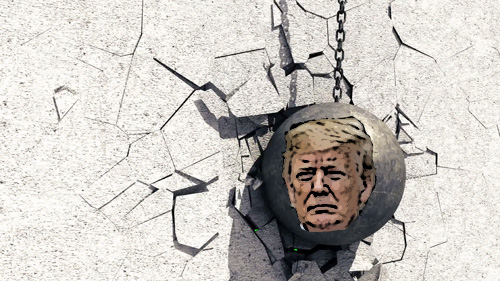

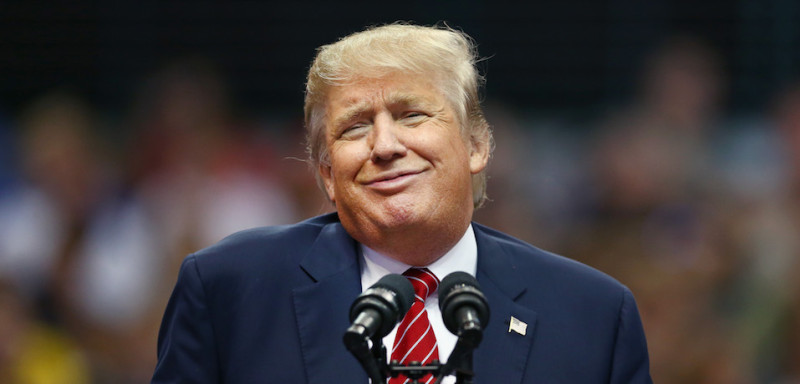

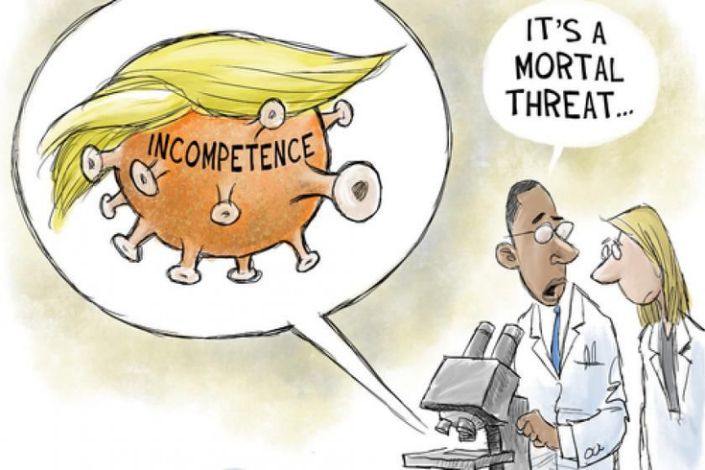
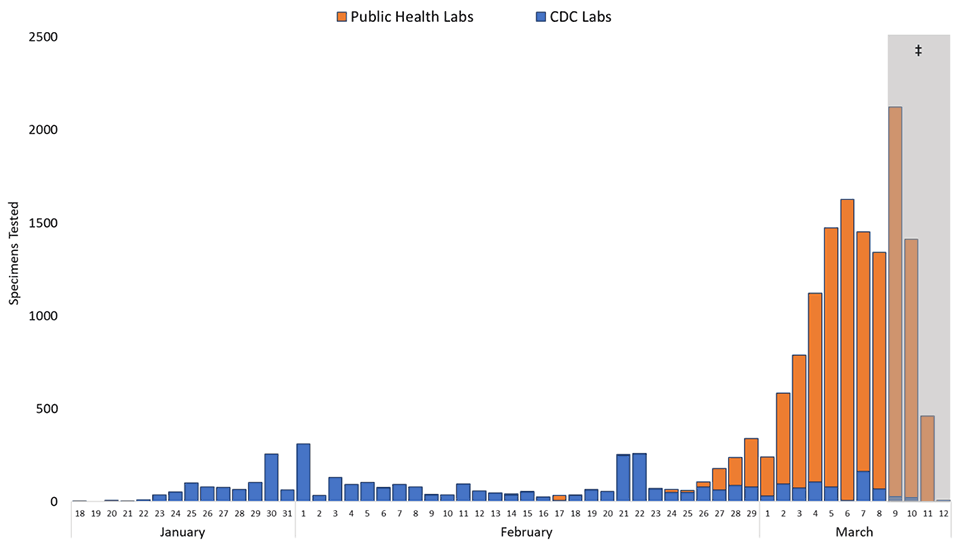 The blue bars are CDC tests conducted; the orange bars are private lab tests conducted. On the best day, March 9, we see there were ‡2,000 tests. This is still frustratingly slow, however, especially compared to
The blue bars are CDC tests conducted; the orange bars are private lab tests conducted. On the best day, March 9, we see there were ‡2,000 tests. This is still frustratingly slow, however, especially compared to 